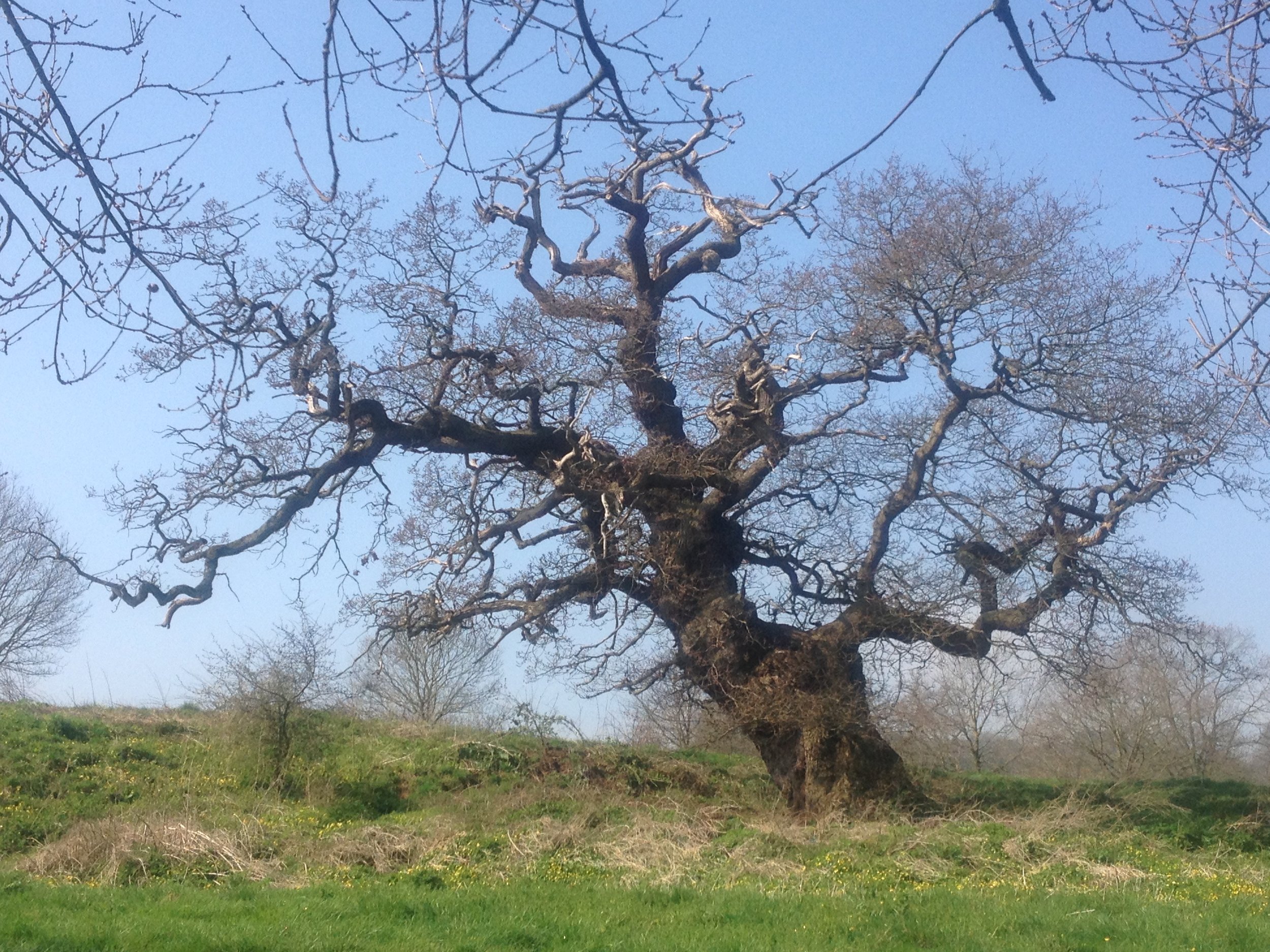‘Oak’ Ashton Court Estate, Bristol
English oak (Quercus robur)
The oak colonised Britain about 9000 years ago after the retreat of the ice, and for nearly 4 millennia Britain was pretty much covered with deciduous oak forest.
“As long as the Lion holds his place as the king of beasts, and the Eagle as king of birds, the sovereignty of British trees must remain to the oak”
John Evelyn in his celebrated book ‘Sylva’, 1664
Oaks are slow growing and, when young, can struggle to compete in closed cover woodland. They often do better in the open, starting life protected by a patch of brambles. The reason historic parklands like Ashton court often have ancient oaks is because deer parks were kept as very open woodland by the browsing deer and provided the ideal conditions for oaks to grow old in.
Oak is one of the most durable and hard timbers and has been used for building for houses and great buildings. A typical Elizabethan farmhouse apparently used 330 oaks. They were the key timber in ship building too, and a man-of-war ship required 3000 oaks! Hence oak plantations were fostered in abundance from 1580 onwards. However England is now running out of oak. The last of the trees planted by the Victorians are now being harvested, and in the intervening century few have been grown. As our ancient oaks start to reach their age limits we need to think ahead. It is extremely easy to grow an oak from an acorn in a pot in the garden and I encourage you to do so and plant it out somewhere for future generations to enjoy. We need the oak not only for its quality timber but because it makes a a huge contribution to biodiversity. The oak supports around 2300 species which use them for food, shelter and breeding habitat. Even in winter they attract many birds such as wrens and long-tailed tits. The acorns are loved by jays and squirrels. Tree creepers and bats roost in their holes or under loose bark. Old oaks are abundant in invertebrates, lichens, mosses and fungi. Even their dead wood provides nourishment to many, many species.
Threats: Oaks face huge challenges. The oak processionary moth and diseases like “acute oak decline” and “powdery mildew” attack oaks. Oaks do not like the warmer wetter winters with their roots sitting in waterlogged soil, and climate change-related drought and flooding make them hugely vulnerable. Acorns need a cold winter with freezing and thawing to break down their hard shells so they can take in water and germinate. So many oaks are also lost through development and inappropriate management of ancient woodland and trees.
Symbolism: Strength, longevity, power, inner strength, overcoming problems. Acorns are a symbol of life, fruitfulness and immortality. The oak leaf represents strength, protection, courage and durability.
About the tree:
This was the first tree I drew, back in April 2015. I remember I had sat for a long time with my eyes closed with my back to the tree and I had an image come in to my mind of a strong and wise-looking elderly man who said to me “Look, really look!”. It felt like it was an invitation to be very present in the world and inspired me to draw the tree as a way of really seeing it.
About Ashton Court Estate:
Ashton Court dates back to before the 11th century and it is referred to in the Domesday Book as a wealthy estate with a manor house, great hall and courtyards. The estate covers 850 acres of woods and open grassland laid out by Humphry Repton. There is a deer park which was started in the 14th century and extended in the 16th and 17th centuries. The estate is abundant in wildlife and has hundreds of veteran trees, over 300 of which are in Clarken Coombe Wood. The Domesday Oak, likely over 700 years old, still grows near Summerhouse Plantation and was selected by The Tree Council as one of 50 Great British Trees. In spring Church Wood has seas of bluebells. In summer the grasslands on the plateau are full of wildflowers including common knapweed, ox-eye daisy and wild carrot and they ring with sound of skylarks that nest here. Top Park Field is also wonderful for wildflowers and abundant in green-winged and common spotted orchids.
Directions:
GPS: ST 55661 71430
What3words: broke.spin.drill
For a hand drawn walking map click here:
Bike or walk:
From Bristol City Centre the National Cycle Route 33-Festival Way goes through the bottom of Ashton Court Estate. From here go up behind the mansion and follow the tarmac path through the parkland. When the track splits take the left fork and after passing a woodland on your left take a left turn through the gap in the fence and you’ll see a knarled and split hawthorn to your right and behind that is the oak tree. It is now surrounded by scrub and oak saplings so looks very different to when I drew it.
Bus:
Take X4 bus from the C7 city centre bus stop, to Clanage Road, Bower Ashton, and its a 10-minute walk past the UWE art college to Ashton Court Estate Mansion House. Instructions are then the same as above.
Car:
Mansion house car park and Clifton Lodge car park open from 8am to dusk. Parking charges apply. Then instructions are the same as above.
